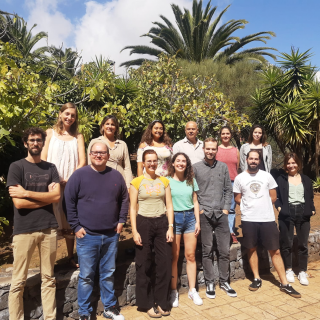Bibcode
Sampaio, V. M.; Aragón-Salamanca, A.; Merrifield, M. R.; de Carvalho, R. R.; Zhou, S.; Ferreras, I.
Bibliographical reference
Monthly Notices of the Royal Astronomical Society
Advertised on:
10
2023
Citations
9
Refereed citations
7
Description
We exploit a sample of 80 000 Sloan Digital Sky Survey central galaxies to investigate the effect of active galactic nucleus (AGN) feedback on their evolution. We trace the demographics of optically selected AGN (Seyferts) as a function of their internal properties and environment. We find that the preeminence of AGN as the dominant ionizing mechanism increases with stellar mass, overtaking star formation for galaxies with Mstellar ≥ 1010 M⊙. The AGN fraction changes systematically with the galaxies' star formation activity. Within the blue cloud, this fraction increases as star formation activity declines, reaching a maximum near the green valley (${\sim} 17 \pm 4~{{\ \rm per\ cent}}$), followed by a decrease as the galaxies transition into the red sequence. This systematic trend provides evidence that AGN feedback plays a key role in regulating and suppressing star formation. In general, Seyfert central galaxies achieve an early-type morphology while they still host residual star formation. This suggests that, in all environments, the morphology of Seyfert galaxies evolves from late- to early-type before their star formation is fully quenched. Stellar mass plays an important role in this morphological transformation: while low-mass systems tend to emerge from the green valley with an elliptical morphology (T-Type ~ -2.5 ± 0.7), their high-mass counterparts maintain a spiral morphology deeper into the red sequence. In high-stellar mass centrals, the fraction of Seyferts increases from early- to late-type galaxies, indicating that AGN feedback may be linked with the morphology and its transformation. Our analysis further suggests that AGN are fuelled by their own host halo gas reservoir, but when in group centrals can also increase their gas reservoir via interactions with satellite galaxies.
Related projects

Traces of Galaxy Formation: Stellar populations, Dynamics and Morphology
We are a large, diverse, and very active research group aiming to provide a comprehensive picture for the formation of galaxies in the Universe. Rooted in detailed stellar population analysis, we are constantly exploring and developing new tools and ideas to understand how galaxies came to be what we now observe.
Anna
Ferré Mateu